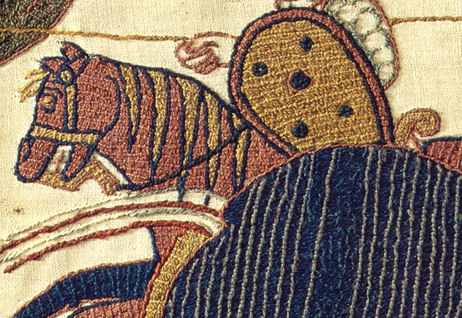Seven Different Types of Needlepoint Fabrics and When to Use Them
Learn about the different types of canvas available for needlepointing: mono, interlock, penelope, rug, plastic, waste, and gauze canvas.
Canvas is always the base fabric for needlepoint embroidery, which makes the end result stiffer and more durable than forms of embroidery like cross stitch, which uses similar stitches on softer fabrics. In fact, needlepoint was called canvas work until the early nineteenth century.
Understanding Needlepoint Canvas Gauges
Needlepoint canvas is woven in a grid with evenly spaced openings between the threads to allow the yarn or thread to pass through easily, without fraying. The number of vertical threads per inch of canvas is called the gauge or fabric count. The lower the gauge, the larger the holes between the threads, and the thicker the yarn or thread that can be used.
All-purpose needlepoint canvas is available in gauges from 5 to 24. Needlepoint stitching on canvas with an indicator of less than 16 is called grospoint. Canvas with a gauge of 16 or higher is used to make the tiny, detailed stitches called petitpoint. Needlepoint gauze canvas for ultra-fine work is available in gauges from 20 to 60.
Single-Mesh Mono, Interlock, and Rug Canvas
These popular types of needlepoint canvas have a single-mesh structure, which means that the woven grid is formed by the junction of one horizontal and one vertical thread. Single-mesh canvas is good for most needlepoint projects.
- Mono canvas is woven of vertical and horizontal threads in a plain over-and-under weave. It is available in a wide variety of gauges and colors. Specific needlepoint stitches don’t work well on mono canvas, such as half-cross stitches. For those, use interlock canvas.
- Interlock canvas is a stiffer and more stable type of single-mesh canvas. It is woven with two vertical threads that are twisted around each other and also twisted around the horizontal threads at the grid intersections. The “locked” construction of the weave makes interlock canvas better for half-cross stitches, which tend to slip on mono canvas. Interlock canvas is available in a wide range of colors and gauges.
- Rug canvas is a very heavyweight canvas woven with two vertical threads that are twisted around each other, and two horizontal threads that aren’t twisted, but lie side by side. The threads can’t be separated. Rug canvas comes in gauges from 3 to 5 and is usually used with very thick yarns made especially for rug-making.
Double-Mesh Penelope Canvas for Combining Small and Large Stitches
Penelope canvas is woven with pairs of vertical threads and pairs of horizontal threads in a way that creates one larger and one smaller opening at each grid intersection. This double-mesh construction makes it possible to separate the double threads and work smaller stitches in the smaller openings, so the same piece of canvas can hold both smaller and larger stitches.
This makes penelope canvas ideal for needlepoint designs with areas of fine detail. The gauge on penelope canvas is given in two numbers: 5/10 or 14/28, for example. The first (smaller) number denotes the number of openings per inch if the meshes are left as is, and the second number designates the number of openings per inch if the threads are separated for smaller stitches.
Plastic Canvas for Extra-Stiff or 3-D Needlepoint
Plastic canvas is molded, not woven, and is quite stiff, which makes it great for 3-D projects such as tissue-box covers or stiff projects like coasters, or bookmarks. Plastic canvas comes in a variety of gauges and precut shapes. It is quite inexpensive and good for practice stitching.
Waste Canvas for Needlepointing Clothing, Tote Bags, and Quilts
Waste canvas makes it possible to needlepoint on fabrics that aren’t woven in a precise grid, such as t-shirts, jeans, quilts, or tote bags. It is called “waste” canvas because it gets removed after stitching. The threads in the waste canvas are held together by water-soluble glue. After stitching, the glue is soaked away, and the fibers pulled out with tweezers, leaving the needlepoint attached to the fabric underneath.
Silk and Polyester Gauze Canvas for Fine Details and Miniatures
The very highest-gauge canvas is an ultra-fine silk or polyester interlock canvas. It is used to make tiny items such as dollhouse rugs or miniature patterns for jewelry. Needlepoint gauze canvas is very expensive, so it is often sold in small pieces premounted on mats.
It Pays to Choose High-Quality Canvas
Good quality materials are essential for creating works of art that last—and they help avoid frustration while you work. Before beginning a needlepoint project, inspect the canvas to make sure the threads have no knots or cuts. The grid should be even, not warped or distorted. Make sure the weave and gauge of the canvas is the right scale for the design and yarn you plan to use. Make sure its stiffness and sturdiness are a good match for the way the needlepointed item will be used.

